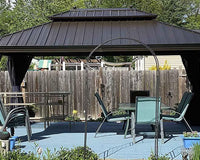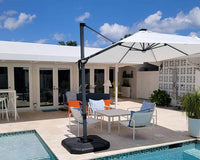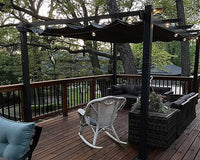Introduction
When you're lounging on your patio, reaching for a cold drink under the shade of your umbrella, a gust of wind sends it spinning. Annoying, right? Well, you're not alone in this struggle. A spinning patio umbrella is a common headache for those who love to chill outdoors. But don't let the wind ruin your relaxation time.
In this article, we're telling some tips and tricks to keep your patio umbrella steady and still, no matter how breezy it gets. Read more and learn to secure your slice of shaded paradise with advice that's easy to follow and even easier to implement.
Understanding Your Patio Umbrella
Whether you have a cantilever umbrella that hangs over your space without a central pole or a classic market umbrella that fits through your patio table, each has its unique features and fixes for spinning issues.
Know Your Umbrella Types
- Cantilever Umbrellas: These offer a range of motion and versatility but can catch more wind due to their design.
- Market Umbrellas: Typically sturdier with a central pole, these are the traditional choice for directly shading your patio table.
- Table Umbrellas: Similar to market umbrellas but specifically designed to be supported by a patio table, providing extra stability.
Identify Stability Influencers
The main parts of the umbrella that influence stability include:
- The Canopy: Larger canopies catch more wind, which can cause spinning.
- The Pole: The material and thickness of the pole contribute to the overall sturdiness.
- The Ribs: These support the canopy; the more durable the ribs, the less likely your umbrella will flip or spin.
How to Choose the Right Umbrella Base
The foundation of a steadfast patio umbrella lies in its base. A well-matched base not only adds to the aesthetic but is crucial for keeping your umbrella upright and spinning-free.
Why the Right Base Matters
- Support: The right base stabilizes your umbrella, especially during windy conditions.
- Compatibility: Not all bases fit all umbrellas; choosing the correct one prevents damage and ensures functionality.
- Safety: A secure umbrella is safer for everyone around it, reducing the risk of it tipping over.
Weight and Material Guidelines
When it comes to stopping the spin, weight, and material are your best allies:
- For Cantilever Umbrellas: You'll need a heavier base, generally upwards of 220 pounds, as these types typically have larger canopies and offset poles.
- For Market and Table Umbrellas: The standard rule is to use a base that is at least 20 pounds for umbrellas up to 4.5 feet in diameter. Add roughly 10 pounds of weight for every additional foot of canopy diameter.
- Material Choices: Concrete, steel, and heavy-duty plastic filled with sand or water are common base materials known for their stability. Choose based on durability, ease of movement (look for bases with wheels if you want portability), and compatibility with outdoor elements.

Trusted Base Models:
Here are some features found in reliable base models:
- Sturdy Build: Look for basesble Inserts: Bases that come with insert rings can adapt to various pole diameters, ensuring a snug fit.
- Locking Mechanism: Some bases include a screw or bolt system to secure the umbrella pole in place and prevent it from twisting.
Keep an eye out for bases that have positive reviews when it comes to their weight distribution and weather resistance. Customer feedback can often provide real-world insights into how well a base holds up under different conditions.
Proper Umbrella Installation Techniques
Installing your patio umbrella correctly is critical to ensure it stays put and provides shade without any mishaps. Start by slotting the pole into the base—make sure it's a snug fit. If your base has several reduction rings, pick one that tightly accommodates your pole size. Once the pole is in place, secure it with the base's tightening mechanism, which could be a screw or bolt. Open the umbrella canopy gently but fully, ensuring it locks into place to prevent unexpected closures. Give it a light shake to confirm everything is stable; there should be no movement at the base or pole.
For umbrellas going through a table, align the hole in the table with the base underneath to provide extra stability; the fit should be tight here as well. For standalone umbrellas, opt for a heavier base, especially if you have a cantilever design with a larger canopy. As a preventative measure, always close the umbrella when not in use to minimize wear from the elements. Using a strap or tie can also help keep the fabric secure and reduce the risk of the umbrella catching wind and spinning. Regular maintenance checks, especially before those windy days start, will keep your umbrella standing tall and steady, ready to protect you from the sun's rays without an unwelcome spin.

Wind-Proofing Strategies for Umbrella
First, there are design features that can help reduce wind resistance for your patio umbrella like Double layer cantilever umbrella .Vented canopies are great, allowing air to pass through. This will minimize the parachute effect that often causes an umbrella to topple or spin. Further, a tilting mechanism can be invaluable, allowing you to angle the umbrella away from the wind, thus reducing the impact.
Other homemade remedies that should work to increase stability include adding extra weight to your umbrella base. One can do this by simply placing a few sandbags around the base or putting bricks or rocks on it. Another good remedy is the use of streamers or ribbons attached to the topmost point of the umbrella, which can distort airflow and reduce wind lift. Look for those that are designed to complement specific design needs in the case of an umbrella. These accessories can give support right where your umbrella needs it, helping to keep it grounded on breezy days.
Maintenance and Care for Increased Umbrella Stability
Maintenance is always required to ensure that the patio umbrella remains a reliable source of shade without the wobble or whirl.
Routine Checks and Adjustments:
- Regularly Check: It will be very important to make it a culture always to check your umbrella's fabric, pole, and base for any damage or worn-out areas that may affect its stability.
- Tighten Connections: All screws, bolts, and fittings should be checked with the view to tightening those that may have loosened over time due to movement or wind.
- NOTE: It is a good idea to have the moving parts of an umbrella with hinges for tilting or opening lubricated with a water-resistant lubricant to make such areas easy to move and prevent rust.
Cleaning and Storage Best Practices:
- Cleaning Regularly: Wash the canopy of your umbrella with mild soap and water to remove dirt and debris. This can keep the look fresh and prevent mold and mildew, which can degrade fabrics and reduce wind resistance.
- Proper Drying: Allow your umbrella to dry out completely before folding it up because this way, the water doesn't get trapped inside the umbrella and subsequently cause rust in its metal parts or mildew.
- Seasonal Storage: Store your umbrella during its off-season in a cool, dry place. Use a protective cover against dust and pests.
- Protective Covers: Even when your umbrella isn't in storage, a weatherproof cover can provide protection against harsh conditions when the umbrella is not in use.
These maintenance and care routines added to your seasonal check will keep your patio umbrella not only lasting longer, but it will also retain its structural integrity.

Securing Your Shade
It's mostly an infuriating thing to have a patio umbrella dance in the wind, but it's an easy problem with the right approach-from choosing a base that's heavy and sturdy to selecting umbrellas that have vented canopies and capability for tilt-you really can significantly reduce wind-related issues. Stability can be further increased by DIY additions such as weights and streamers. Regular maintenance checks, lubrication of mobile parts, and good cleaning routines will also protect functionality and appearance.
Finally, taking the time to properly store it when not in use prevents damage and has your patio umbrella ready at any time to provide a stable retreat of shade on sunny days. Keep these tips in mind, and you're set for a serene outdoor experience without having to run after a whirling umbrella.




